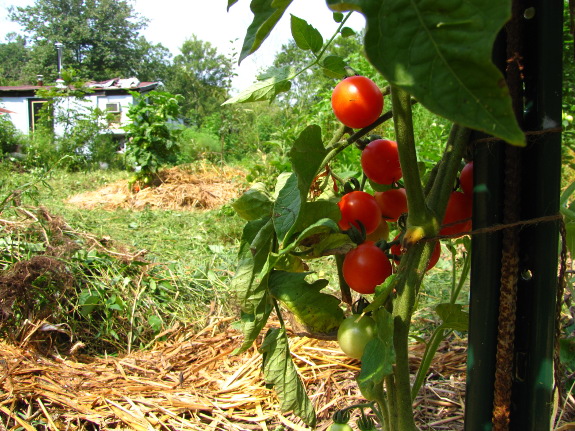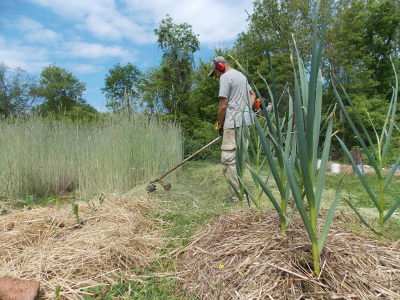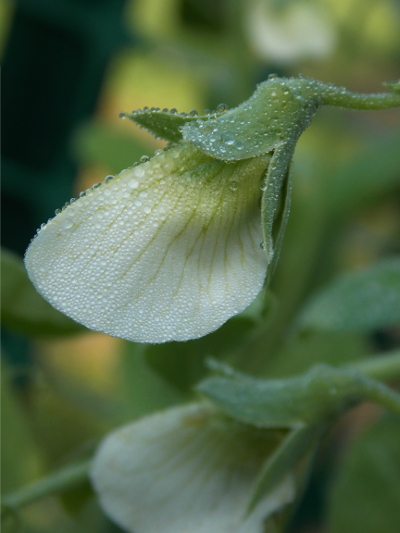
Planning ahead for subirrigated tomatoes
 This year's tomatoes went in
the ground less than two weeks ago, and I'm already planning ahead for
next year. I've had good luck for the last two years choosing a subirrigated spot as a blight-control
measure, but I want to keep the tomato patches on at least a three year
rotation, which means I needed to find yet one more garden area with
high groundwater.
This year's tomatoes went in
the ground less than two weeks ago, and I'm already planning ahead for
next year. I've had good luck for the last two years choosing a subirrigated spot as a blight-control
measure, but I want to keep the tomato patches on at least a three year
rotation, which means I needed to find yet one more garden area with
high groundwater.
The back garden is the
obvious solution. Unfortunately, previous owners let that area's
topsoil completely erode away, so it's a bit more like a swamp than
like a true subirrigated garden. Which is all a long way of
explaining why the back garden is in the midst of a 12-month cover-crop
rotation to get ready for tomato season 2014.
 Much of the back garden has
actually already been in cover crops for over a year. I sowed
annual ryegrass in early March 2012, kill-mulched in early summer, then
planted buckwheat in any beds that weren't needed to reach last year's
vegetable quota. At the end of October, the whole area went into rye, which grew up over my head
despite sodden and poor soil.
Much of the back garden has
actually already been in cover crops for over a year. I sowed
annual ryegrass in early March 2012, kill-mulched in early summer, then
planted buckwheat in any beds that weren't needed to reach last year's
vegetable quota. At the end of October, the whole area went into rye, which grew up over my head
despite sodden and poor soil.
Before Mark
cut the rye this week,
I scattered buckwheat seeds amid the standing stalks, and I plan to ask
Mark to pee on each bed in turn to add nitrogen to the soil. This
is my  version of Fukuoka's
do-nothing grain rotation, except that I don't let the
grains go to seed and instead grow them for biomass production. I
figure I'll have enough summer to plant buckwheat three more times in
these beds, before either repeating the winter rye experiment or using
oilseed radishes there for the winter instead.
version of Fukuoka's
do-nothing grain rotation, except that I don't let the
grains go to seed and instead grow them for biomass production. I
figure I'll have enough summer to plant buckwheat three more times in
these beds, before either repeating the winter rye experiment or using
oilseed radishes there for the winter instead.
My hope is that by this
time next year, I'll stop thinking of the back garden as terrible soil,
and can upgrade it to "good soil as long as I add a lot of manure every
year."
(In case you're
wondering, the pea flower has absolutely nothing to do with
tomatoes. I just thought it was pretty and wanted to share.)
Want more in-depth information? Browse through our books.
Or explore more posts by date or by subject.
About us: Anna Hess and Mark Hamilton spent over a decade living self-sufficiently in the mountains of Virginia before moving north to start over from scratch in the foothills of Ohio. They've experimented with permaculture, no-till gardening, trailersteading, home-based microbusinesses and much more, writing about their adventures in both blogs and books.
Want to be notified when new comments are posted on this page? Click on the RSS button after you add a comment to subscribe to the comment feed, or simply check the box beside "email replies to me" while writing your comment.

here's the actual link
http://www.nytimes.com/2013/05/30/garden/in-defense-of-grafting-tomatoes.html
It's a well-kept secret that tomatoes don't have to be rotated. No less an authority than Eliot Coleman says, and my own experience and others' as reported on the web bears out, that a well-tended tomato patch just keeps getting better year after year, and absolutely no need to fuss with disposing of blight-infected plants at the end of the season, just let them add their dynamic to and be dealt with by the rich and robust mix. So "you must rotate your tomatoes" is just another garden myth repeated ad nauseum. Or, if you must use the same spot, you are advised to replace the soil. What a waste of labour.